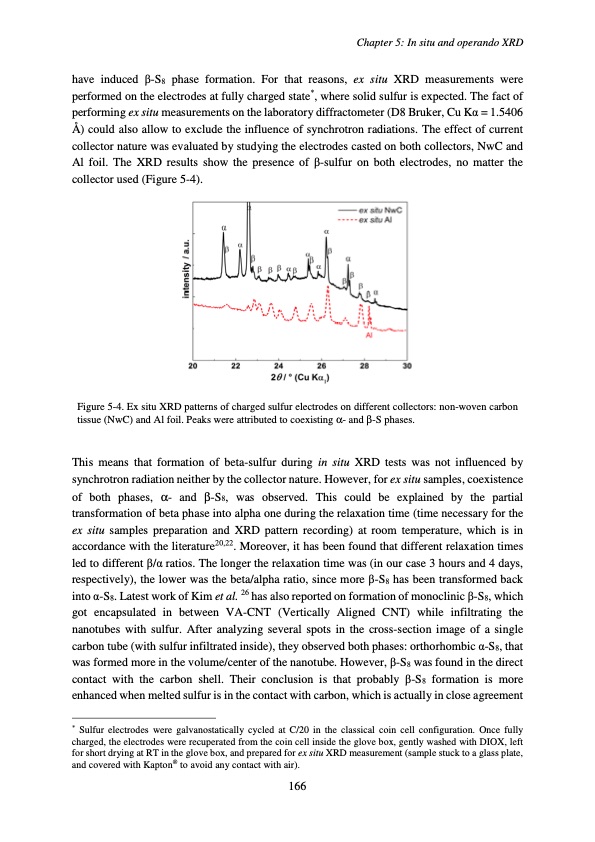
PDF Publication Title:
Text from PDF Page: 170
have induced β-S8 phase formation. For that reasons, ex situ XRD measurements were performed on the electrodes at fully charged state*, where solid sulfur is expected. The fact of performing ex situ measurements on the laboratory diffractometer (D8 Bruker, Cu Kα = 1.5406 Å) could also allow to exclude the influence of synchrotron radiations. The effect of current collector nature was evaluated by studying the electrodes casted on both collectors, NwC and Al foil. The XRD results show the presence of β-sulfur on both electrodes, no matter the collector used (Figure 5-4). Figure 5-4. Ex situ XRD patterns of charged sulfur electrodes on different collectors: non-woven carbon tissue (NwC) and Al foil. Peaks were attributed to coexisting α- and β-S phases. This means that formation of beta-sulfur during in situ XRD tests was not influenced by synchrotron radiation neither by the collector nature. However, for ex situ samples, coexistence of both phases, α- and β-S8, was observed. This could be explained by the partial transformation of beta phase into alpha one during the relaxation time (time necessary for the ex situ samples preparation and XRD pattern recording) at room temperature, which is in accordance with the literature20,22. Moreover, it has been found that different relaxation times led to different β/α ratios. The longer the relaxation time was (in our case 3 hours and 4 days, respectively), the lower was the beta/alpha ratio, since more β-S8 has been transformed back into α-S8. Latest work of Kim et al. 26 has also reported on formation of monoclinic β-S8, which got encapsulated in between VA-CNT (Vertically Aligned CNT) while infiltrating the nanotubes with sulfur. After analyzing several spots in the cross-section image of a single carbon tube (with sulfur infiltrated inside), they observed both phases: orthorhombic α-S8, that was formed more in the volume/center of the nanotube. However, β-S8 was found in the direct contact with the carbon shell. Their conclusion is that probably β-S8 formation is more enhanced when melted sulfur is in the contact with carbon, which is actually in close agreement * Sulfur electrodes were galvanostatically cycled at C/20 in the classical coin cell configuration. Once fully charged, the electrodes were recuperated from the coin cell inside the glove box, gently washed with DIOX, left for short drying at RT in the glove box, and prepared for ex situ XRD measurement (sample stuck to a glass plate, and covered with Kapton® to avoid any contact with air). Chapter 5: In situ and operando XRD 166PDF Image | Accumulateur Lithium Soufre

PDF Search Title:
Accumulateur Lithium SoufreOriginal File Name Searched:
WALUS_2015_archivage.pdfDIY PDF Search: Google It | Yahoo | Bing
Sulfur Deposition on Carbon Nanofibers using Supercritical CO2 Sulfur Deposition on Carbon Nanofibers using Supercritical CO2. Gamma sulfur also known as mother of pearl sulfur and nacreous sulfur... More Info
CO2 Organic Rankine Cycle Experimenter Platform The supercritical CO2 phase change system is both a heat pump and organic rankine cycle which can be used for those purposes and as a supercritical extractor for advanced subcritical and supercritical extraction technology. Uses include producing nanoparticles, precious metal CO2 extraction, lithium battery recycling, and other applications... More Info
| CONTACT TEL: 608-238-6001 Email: greg@infinityturbine.com | RSS | AMP |